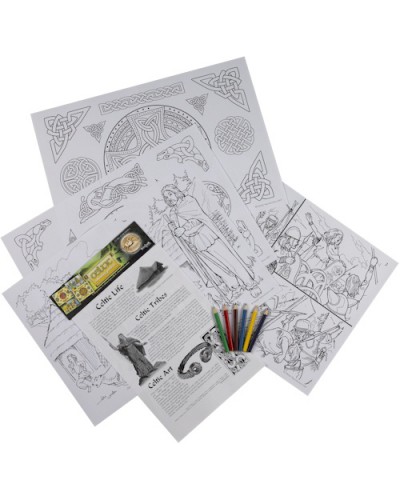Product Description: The Celtic Colouring Posters consists of four A3 size colouring sheets, six colouring pencils and a Celtic factsheet. The colouring posters include a single image of a Celtic Village scene, Celtic knotwork, Celtic zoomorphics, and a poster depicting four images of the rise and fall of Boudicca. The factsheet explains who the Celts were, their coins, Celtic Life, their tribes and their art and there is also a crossword to complete. There is a colourful header card that has pictures showing how the posters could be coloured in and information on a Celtic coin and the Iron Age. All are held in a clear cellophane bag.
Information: The Celts were a diverse group of tribal societies in Iron Age Europe who flourished from 750 BC for nearly 800 years. They spoke related languages, shared similar customs and beliefs and created beautiful artworks in both metal and stone. These tribes lived across a vast area from the British Isles, across Europe to the borders of Russia and borrowed many ideas and designs from other peoples like the Greeks, Romans and Etruscans. From 150 BC – 125 BC large groups of Celts started arriving into Britain from ancient Gaul (France) and Belgium. What was important about the invaders was that they bought money with them in the shape of real coinage. Before the arrival of these Celtic tribes the trading system used had been bartering for goods and services, trading one thing for another.
The majority of Celtic coins were struck by hand. They were used for approximately 150 years and were detailed in a rich variety of designs made from gold, silver and bronze. Many of the coins were created in the styles of earlier Greek coins showing gods on one side and chariots on the reverse.
The Celts were farmers who lived in isolated small villages, built close to sources of essential supplies. These included water, fish and animals for hunting, timber, meadowland for grazing livestock and copper and iron ore for smelting metals. As well as growing crops like wheat and corn the Celts also kept a variety of animals. These included cows, goats, pigs, sheep and geese. The Celtic lived in roundhouses with thatched roofs of straw or heather. The walls of their houses were made from local materials like wattle (woven wood) and daub (straw and mud) or were made with large stones held together with clay.
Between 125 BC – 75 BC tribes from the continent spread into southeast Britain. In 55 BC Julius Caesar made his first expedition into Britain where he was confronted by the Cantii tribe. The following year Caesar led a second expedition to Britain and was again confronted by a Celtic tribe called the Atrebates. After many skirmishes he managed eventually to defeat this tribe with help from the Trinovantes, tribal enemies of the Atrebates.
Boudicca was born into the Iceni tribe c.35 – 40 AD she married the king of the Iceni, Prasutagus, and when he died she became the tribal leader. In 43 AD the Roman army of Claudius invaded Britain. Boudicca and many Celtic tribes suffered greatly at the hands of the Romans and she promised to fight back against them. She raised an army of over 100,000 Celtic warriors (c.60 – 61 AD), including warriors from other tribes like the Trinovantes, and destroyed the Roman towns of Camulodonum (now Colchester), Londinium (now London) and Verulamium (now St. Albans). The Romans gathered thousands of soldiers and marched to face Boudicca and her armies. The battle raged all day and, although outnumbered, the Romans defeated the Celtic army and took few prisoners. Boudicca not wanting to be captured took her own life taking poison.
Many Celts were skilled craftsmen and metal workers. Their knotwork designs were used on stone, manuscripts and metal jewellery. This interlocking design represented eternal spiritual growth and the interlaced knotwork decorating the cross, was a popular Celtic pattern. Animals, birds and reptiles, interlaced with Celtic knotwork designs, are called Zoomorphics. These creatures were sacred to the Celts and were often used to represent their gods and spirits. Christ was identified by a number of symbolic animals, including the fish.
Tags: Celtic, Educational, Colouring, Posters

